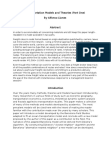Transportation Models and Theories (Part One
By Alfonso Llanes
In order to accommodate all concerning materials and still keep this paper length-readable it is made available in two parts. Freight rates in nodal format based on origin-destination published by carriers; leave out minor ports in the network. Using a minimal approach of 50 nodal points to cover the entire world, carriers can reduce the number of individual rates to (50)²= 2,500 for each service type that can easily be kept and updated in a data base thus, avoiding storage and updates of millions of rates. It fallows that with this recipe, carriers can use algorithms for covering the ports in the network not included in the nodes. The balancing act relies in developing an algorithm that works across all service types within the 50 nodes. For instance, if 4 service types are considered it would render 4*2,500= 10,000 rates with all its attributes. Even though this method can work for carriers, how does a freight broker keep track of all the possible combinations of routes and rates? How does a manufacturer find out about a particular freight rate before committing to a production-delivery contract? The list goes on to include traders, bankers, governments and individuals who need to know freight rates as accurately as possible in any part of the world in the age of the Internet with instantaneous response for a management board in session?